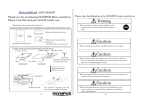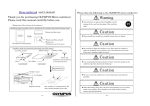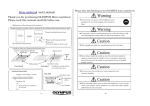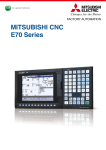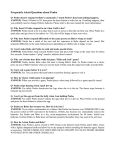Download Micro cantilever 取り扱い説明書
Transcript
Please obey the following to the OLYMPUS micro cantilevers user’s manual Thank you for purchasing OLYMPUS Micro cantilevers. Please read this manual carefully before use. <Explanation of the part of the products> Warning Use protective eye glasses when handling to avoid damage to the eyes from breakage of the cantilever chips. Cantilever chips in a plastic case are included in the envelope with manual and spec sheet. Manual and Specification sheet Label Caution Please handle our cantilevers carefully because they are fragile. Plastic pack (translucent blue) Plastic case (Cantilever chips are in the case) Envelope for transportation Cantilever chips are contained in the plastic case (Tac carrier) Adhesive sheet Case (Tac carrier) Cantilever chips Upside Down side Case Label Tape Case (open) Case (closed) Cantilevers are tip-side-up as viewed in the case. Magnified illust. Case label BL-AC10DS-A2 1.5 (MHz) 0.1 (N/m) Product name Cantilever Lot Number Cantilever chip (substrate) Caution Do not drop or shake the cantilever case. Even when the cantilever chips are contained in the cantilever case, the cantilevers may break if the case is handled roughly or jarred. Caution It is recommended that precautions be taken to prevent damage to the cantilever tips from electrostatic discharge. Caution When discarding, please obey the laws and regulations in your country and/or your company. These cantilevers are made of silicon nitride and gold/chromium. Inspection stamp -- One cantilever elongates from the side of round shoulders of the chip. - 1e - - 2e - Special feature of OLYMPUS Micro cantilever (BL-AC10DS-A2) 1. Short and thin cantilever This small silicon-nitride cantilever is suitable for high speed AFM measurement in water and shows high resonance more than 300 kHz (500 kHz (typ.)) in water while it is soft enough for revealing soft bio samples (spring constant 0.1 N/m (typ.)). It shapes in bird-beak, sized 9 m(L) x 2 m(W) x 0.13 m(T). It should be used in AFMs which deflection sensor illuminate cantilevers with their laser spot less than 5 m in diam. (ideally less than 2 m). 2. Monolithic tip The triangular portion near the cantilever free-end laps under at an angle of 35 degrees and the corner of the triangular portion behave as an actual probe with its tip radius of 24 nm (typ.). The tip and lever are monolithic so that tip-breakage around the interface of tip and lever is avoidable. 1 Preparation 1) Please prepare the followings before using OLYMPUS cantilevers. 2) To gain a better understanding of how cantilevers and chips are connected, cantilevers should be inspected under the microscope. 1) Work environment :Clean bench (Use of an electrical charge neutralizer of ionizer is recommended.) 2) For hazard avoidance :Protective eye glasses 3) For cantilever treatment:Tweezers (sharp pointed tip) :Thin stick like Toothpick, Both side adhesive tape :Anti-static mat (Use of tweezers made of insulator is recommended.) (Use of anti-electrostatic discharge mat and a wrist band is recommended.) 4) For inspection :Stereo microscope 3) Wind both-side adhesive tape around the top of the thin stick to prepare an adhesive stick for picking up the chips from the cantilever wafer 3. Tip View This cantilever is shaped like bird-beak so that the tip is located at the very end of the cantilever. This feature allows you to set the tip over a point of interest on the sample, easily and precisely, if you use an AFM combined with an optical microscope. 4. Gold reflex coating Gold is coated on the back side of the cantilevers for optical deflection sensing. 5. Pre-separated chip The chips can be attached to the AFM instrument as soon as the case is open. See the specification sheet of OLYMPUS Micro cantilevers at the last page of this manual. Table of contents 1 page 4e Preparation 2 Open the case 4e 3 Picking up the cantilever chip from the case 5e 4 Attaching the cantilever chip to your instrument 6e 5 Plate-like tip 7e 6 When attaching a cantilever chip to AFM 7e 7 Making an additional tip on the tip 8e 8 Information 8e 9 Specification 1s - 3e - 2 Open the case Caution Please handle our cantilevers carefully because they are fragile. Caution It is recommended that precautions be taken to prevent damage to the cantilever tips from electrostatic discharge. 1) It is recommended that the cantilever case be opened in a clean environment like a clean bench in order to avoid the cantilever being contaminated. Handling under an ionizer is recommended. 2) Avoid wearing clothes like woolen sweaters, fleece etc that give off the static electricity when handling the cantilever cases and chips. Use of an anti-electrostatic mat and wrist band is preferable. - 4e - 3) In opening the case, put the plastic case label-side down on a desk. The cantilevers are tip-side-up as viewed in the case. 4) Open the case. 3 4 Attaching the cantilever chips to your instrument 1) Please read the instruction manual of your scanning probe microscope before this operation. This cantilever can not be used at a commercially SPM due to its smallness, 9 m(L) x 2 m(W) x 0.13 m(T). To attach the cantilever chip to the chip holder in your SPM, Picking up the cantilever chip from the case Caution Avoid any contact with the cantilevers when you pull up the cantilever tip from the case. Caution 2) Place the chip on the adhesive stick gently against the prescribed part in your chip holder. (see left below) 3) Press the center of the chip with sharp pointed tweezers and pull apart the stick from the chip. (see right below) 4) Lock the chip into the chip holder in accordance with the manner described in the manual of your SPM. Most of the chip holders in AFMs use a leaf spring or a wire for pressing the chip to the holder. It is recommended that the chip is pressed with those at the center of the chip to achieve a good mechanical coupling between the chip and the holder. Cantilever chips should always be placed tip-side-up. 1) Press down gently on the part between the center and one third of the chip along the center line with the adhesive stick (see left below). 2) Do not press the chip too much, or the chip might be buried in the Gel sheet and the cantilever must break. 3) Pull up the stick carefully, then the adhered chip is picked up together (see below). Note) To avoid contact with the cantilever, the tweezers should not access to the chip from cantilever side. Put the tweezers on the chip like following illustration. Note : Some of both-side adhesive tapes have not enough adhesive to pick up the chip from the Gel sheet. Then use the tweezers for this procedure. - 5e - - 6e - 5 Plate-like tip 7 Lever Tip 35 deg. 1um Substantive tip Left image is an SEM image of the cantilever apex viewing from the side. The plate-like tip is located at the end of the cantilever. The plate-like tip elongates by around 1 m with its tip-tilt-angle at 35 degrees with respect to the normal line of the cantilever. Its corner edge of the plate-like tip looks like a miniature tetrahedral tip and behaves as the substantive tip during the scanning 6 When attaching a cantilever chip to AFM As illustrated below, the cantilever is short and small. The chip edge and sample surface should be kept parallel to each other in the AFM system to avoid any contact of a chip shoulder and the sample surface. It is strongly recommended that both of bottom-side surface of the chip and chip holder be kept clean and particle-free. A contamination particle between them might tilt the chip to contact them each other. While observing the lever and chip with an optical microscope of your AFM system, you may find bright line or belt as shown in the illustration below. It works as a guide to find the small cantilever before adjusting sensor optics. The cantilever locates near the center of the bright line. Chip edge Cantilever Making an additional tip on the tip The tip radius is less than 30 nm. For higher-resolution in measurements, it is recommended to fabricate another thin wire tip like a carbon at the apex of the tip. 8 Information Please contact following if you have any question on this user’s manual. OLYMPUS CORPORATION Microtechnology R&D Division 2-3 Kuboyama-cho Hachioji-shi Tokyo 192-8512 Japan Email : [email protected] Please access to the web page of OLYMPUS micro cantilevers. http://www.olympus.co.jp/probe Bright line Bottom-side surface of the chip Chip shoulders Ver.1.1 Jul. 7, 2010 Schematic view of cantilever chip - 7e - OLYMPUS CORPORATION - 8e -




